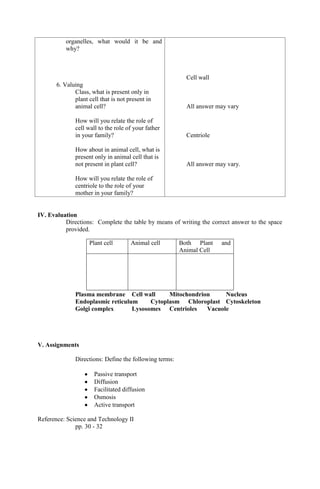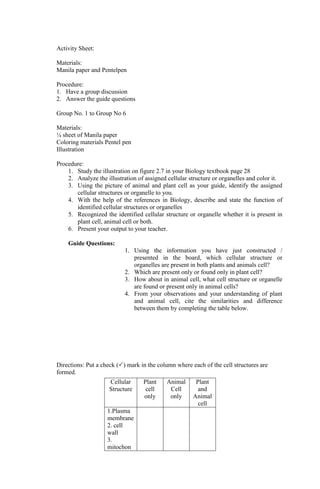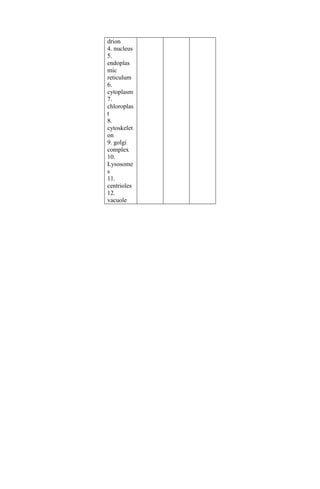Animal and plant cell ok
- 1. Republic of the Philippines Department of Education Region IV-A CALABARZON Division of Lipa City Anilao National High School Anilao, Lipa City I. Objectives Identify the cellular structure Discuss the differences between plant and animal cell Appraise the importance of cell to all organisms II. Subject Matter a. Topic: Particles that make up an atom b. References: Biology Textbook pp. 28, http://www.google.com//animalandplantcell c. Materials For Teachers For Students Pictures Manila paper Manila Paper Marker Chalk and Board Book III. Lesson Development Teacher’s Activity A. Daily Routine a. Prayer b. Greetings Good Morning Class! c. Checking of Attendance and Assignment B. Recall Last meeting we discussed about the discovery of cell and the cell theory, for us to know if you really understand our previous topic, I have here a prepared activity. I have posted here a chart where it contains columns. The Column A and the column B. Those in column A are the names of scientists while in column B is the discoveries they contribute to the field of Biology. I need 5 volunteers to do this task. Do I make my instructions clear? Very good! It seems that you really Students’ Activity Good Morning, sir! Directions: Match Column A to Column B. write your answer on the space provided before each item. Column A Column B ___1.Rudolf Virchow ___2. Robert Hooke ___3.Mattias Schleiden and Theodore Scwann ___4.Johannes Purkinje ___5. Robert Brown a. Cell theory b. Protoplasm c. Nuclei d. “cell arise from pre – existing cell” e. cellular structure f. First used the term “cell” Yes, sir.
- 2. understand our previous topic. Now, let’s go on to our next topic. C. Motivation Class, I have here a prepared task for you. This is entitled “Girl vs. Boy”. The group 1 will be the boys and the Group 2 will be the girls. What you’re going to do is to arrange the puzzled picture posted on the board. The first group who finished the task will be our winner. Is that clear? What is the word being formed? Very good! So class, what do you think will be our topic for today? D. Lesson Proper 1. Pre – Activity a. Presentation We all know that all organisms are made up of cell. Cell is the basic unit of all forms of life. Did you know class that cells have its parts and every part of it has its function? Those parts that I am mentioning here are commonly termed as “organelles” Today, we will be able to identify the cellular structure of both plant and animals cell, we will be able to discuss the differences between plants and animals cell and we will also appraise the importance of cell in all organisms. So class, get ready! b. Discussion of Procedure I will group you into 6. Each group will be given 10 minutes to do the task. c. Points to Remember But before we start out task, I want you to introduce my friend NARUTO and he has a message to each and every one of you. Yes, Sir Cellular Structure Cellular Structure Yes sir! N – oise must be avoided A – ttentive listening R – ead the direction carefully U – nderstand the direction and instructions Cellular Structure
- 3. d. Distribution of Materials (The students will get their materials from their teacher.) 2. Activity proper (Refer to activity sheet provided by the teacher.) 3. Post Activity a. Presentation of Output b. Discussion and Analysis of Data Okay class, let’s analyze your work if they are correct. Using the information you have just presented in the board, which cellular structures or organelles are present in both plant and animal cell? Precisely! Which are present only/found only in plant cell? How about in animal cell? What cell structure is present only in animal cell? Now class, are the information about the structure of plant and animal cell clear to you? 4. Generalization Class, Using the illustration posted on the board, label the parts of the cell. Is that clear? I need volunteers to this task. 5. Application Class, if you were given a chance to be one of the cellular structures and T – ime management O – bserve cleanliness Plasma membrane, Mitochondrion, Nucleus, endoplasmic reticulum, Cytoplasm, Cytoskeleton, Golgi complex, Lysosomes, and Vacuole Cell wall and Chloroplast Centriole Yes Sir! Yes Sir! All answer may vary.
- 4. organelles, what would it be and why? 6. Valuing Class, what is present only in plant cell that is not present in animal cell? How will you relate the role of cell wall to the role of your father in your family? How about in animal cell, what is present only in animal cell that is not present in plant cell? How will you relate the role of centriole to the role of your mother in your family? Cell wall All answer may vary Centriole All answer may vary. IV. Evaluation Directions: Complete the table by means of writing the correct answer to the space provided. Plasma membrane Cell wall Mitochondrion Nucleus Endoplasmic reticulum Cytoplasm Chloroplast Cytoskeleton Golgi complex Lysosomes Centrioles Vacuole V. Assignments Directions: Define the following terms: Passive transport Diffusion Facilitated diffusion Osmosis Active transport Reference: Science and Technology II pp. 30 - 32 Plant cell Animal cell Both Plant and Animal Cell
- 5. Prepared by: ___________________ Christian Jay D. Salazar Student Teacher Checked by: ________________________ Mrs. Rosemarie C. Calacasan Cooperating Teacher
- 6. Activity Sheet: Materials: Manila paper and Pentelpen Procedure: 1. Have a group discussion 2. Answer the guide questions Group No. 1 to Group No 6 Materials: ¼ sheet of Manila paper Coloring materials Pentel pen Illustration Procedure: 1. Study the illustration on figure 2.7 in your Biology textbook page 28 2. Analyze the illustration of assigned cellular structure or organelles and color it. 3. Using the picture of animal and plant cell as your guide, identify the assigned cellular structures or organelle to you. 4. With the help of the references in Biology, describe and state the function of identified cellular structures or organelles 5. Recognized the identified cellular structure or organelle whether it is present in plant cell, animal cell or both. 6. Present your output to your teacher. Guide Questions: 1. Using the information you have just constructed / presented in the board, which cellular structure or organelles are present in both plants and animals cell? 2. Which are present only or found only in plant cell? 3. How about in animal cell, what cell structure or organelle are found or present only in animal cells? 4. From your observations and your understanding of plant and animal cell, cite the similarities and difference between them by completing the table below. Directions: Put a check () mark in the column where each of the cell structures are formed. Cellular Structure Plant cell only Animal Cell only Plant and Animal cell 1.Plasma membrane 2. cell wall 3. mitochon






